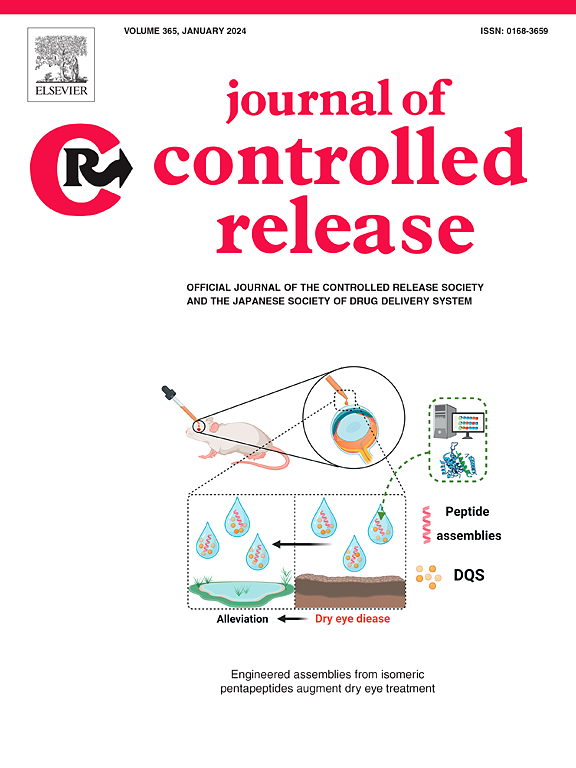A comprehensive evaluation of stability and safety for HEK293F-derived extracellular vesicles as promising drug delivery vehicles
IF 11.5
1区 医学
Q1 CHEMISTRY, MULTIDISCIPLINARY
引用次数: 0
Abstract
HEK293F-derived extracellular vesicles (HEK293F-EVs) have great potential as next-generation drug delivery vehicles. A comprehensive understanding of their batch stability and in vivo safety is prerequisite for clinical translation. HEK293F-EVs were purified using ultracentrifugation combined with size exclusion chromatography, and their physicochemical properties, such as morphology, size distribution, and biomarkers, were thoroughly characterized. Raman spectroscopy and multi-omics analyses were employed to elaborate their molecular composition. Blood kinetics and biodistribution were assessed via IVIS spectrum imaging. Additionally, long-term in vivo safety was evaluated following multiple-dose administration through hematology, serum biochemistry, cytokine/chemokine profiling, and histopathology. HEK293F-EVs exhibited stable yields, purity, physicochemical properties (morphology, size, zeta potential, and marker proteins), and chemical composition across different cell passages (P10, P20, P30), with no significant variations. Content profiling, including protein, miRNA, metabolite, and lipid, confirmed consistent molecular stability across five production batches. GO, Reactome, and KEGG analyses revealed minimal enrichment in pathways related to acute immune response or cytotoxicity. Blood kinetics studies indicated rapid clearance of HEK293F-EVs from circulation, though slightly slower than PEG-Liposomes. Organ biodistribution was comparable between HEK293F-EVs and PEG-Liposomes, with HEK293F-EVs potentially having longer retention times. Importantly, HEK293F-EVs exhibited a favorable preclinical long-term safety profile, showing low immunogenicity and fewer tissue lesions compared to PEG-Liposomes. Our study demonstrates that HEK293F-EVs maintain stable physicochemical characteristics and compositions across batches and possess a superior safety profile, suggesting their significant potential as a safe and reliable drug delivery platform for clinical applications.


hek293f来源的细胞外囊泡作为有前途的药物递送载体的稳定性和安全性的综合评价
hek293f衍生的细胞外囊泡(hek293f - ev)作为下一代药物递送载体具有巨大的潜力。全面了解它们的批稳定性和体内安全性是临床转化的先决条件。对hek293f - ev采用超离心结合粒径排阻色谱法进行纯化,并对其形态、粒径分布、生物标志物等理化性质进行全面表征。利用拉曼光谱和多组学分析分析了它们的分子组成。通过IVIS光谱成像评估血液动力学和生物分布。此外,通过血液学、血清生化、细胞因子/趋化因子分析和组织病理学评估多剂量给药后的长期体内安全性。hek293f - ev在不同传代(P10、P20、P30)中表现出稳定的产量、纯度、理化性质(形态、大小、zeta电位和标记蛋白)和化学成分,无显著变化。含量分析,包括蛋白质、miRNA、代谢物和脂质,证实了五个生产批次的分子稳定性一致。GO、Reactome和KEGG分析显示,与急性免疫反应或细胞毒性相关的途径中富集程度极低。血液动力学研究表明hek293f - ev从循环中迅速清除,尽管比peg脂质体略慢。hek293f - ev和peg -脂质体之间的器官生物分布相似,hek293f - ev可能具有更长的保留时间。重要的是,hek293f - ev表现出良好的临床前长期安全性,与peg脂质体相比,具有低免疫原性和更少的组织病变。我们的研究表明,hek293f - ev在不同批次中保持稳定的物理化学特性和成分,具有优越的安全性,表明其作为临床应用的安全可靠的给药平台的巨大潜力。
本文章由计算机程序翻译,如有差异,请以英文原文为准。
求助全文
约1分钟内获得全文
求助全文
来源期刊

Journal of Controlled Release
医学-化学综合
CiteScore
18.50
自引率
5.60%
发文量
700
审稿时长
39 days
期刊介绍:
The Journal of Controlled Release (JCR) proudly serves as the Official Journal of the Controlled Release Society and the Japan Society of Drug Delivery System.
Dedicated to the broad field of delivery science and technology, JCR publishes high-quality research articles covering drug delivery systems and all facets of formulations. This includes the physicochemical and biological properties of drugs, design and characterization of dosage forms, release mechanisms, in vivo testing, and formulation research and development across pharmaceutical, diagnostic, agricultural, environmental, cosmetic, and food industries.
Priority is given to manuscripts that contribute to the fundamental understanding of principles or demonstrate the advantages of novel technologies in terms of safety and efficacy over current clinical standards. JCR strives to be a leading platform for advancements in delivery science and technology.
 求助内容:
求助内容: 应助结果提醒方式:
应助结果提醒方式:


